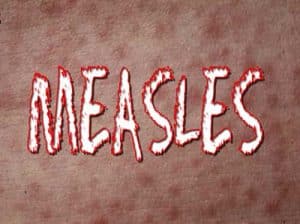 On the afternoon of August 6th, a teenager visiting with her parents from overseas boarded a cruise ship in Vancouver (British Columbia) that was bound for Alaska. Approximately one week prior to boarding the cruise ship, the patient began experiencing cold-like symptoms while travelling in Thailand, and four days prior to boarding she woke up with a rash (facial), red eyes, and feverishness. Within several hours of boarding the ship, the child was put in medical isolation due to persistence of symptoms and the concern for possible measles. Per the parents, the child had never received the measles, mumps, and rubella (MMR) vaccine. The patient remained in medical isolation until August 8th when she was transported to PeaceHealth Ketchikan Medical Center. The patient was discharged from the hospital on August 10th. Later that day, the patient was confirmed by polymerase chain reaction (PCR) testing to have been infected with the measles virus.
On the afternoon of August 6th, a teenager visiting with her parents from overseas boarded a cruise ship in Vancouver (British Columbia) that was bound for Alaska. Approximately one week prior to boarding the cruise ship, the patient began experiencing cold-like symptoms while travelling in Thailand, and four days prior to boarding she woke up with a rash (facial), red eyes, and feverishness. Within several hours of boarding the ship, the child was put in medical isolation due to persistence of symptoms and the concern for possible measles. Per the parents, the child had never received the measles, mumps, and rubella (MMR) vaccine. The patient remained in medical isolation until August 8th when she was transported to PeaceHealth Ketchikan Medical Center. The patient was discharged from the hospital on August 10th. Later that day, the patient was confirmed by polymerase chain reaction (PCR) testing to have been infected with the measles virus.
Measles patients are generally considered to be contagious starting four days before rash onset and ending four days after rash onset. Non-immune persons who are in close proximity to an infected person during this timeframe are at risk of developing measles; however, the risk of transmission is considered to be very low by the fourth day after rash onset.
Although this child was at the tail end of infectiousness when she boarded the cruise ship (day four after rash onset), out of an abundance of caution, the Centers for Disease Control and Prevention has advised the cruise ship to notify all passengers and crew members who might have been exposed to the patient on August 6th to be alert for potential signs and symptoms of measles and to seek medical consultation if symptoms arise.
The cruise ship passengers disembarked in Seward on the morning of August 13th, and many will be travelling throughout Alaska for a period of time before returning home. While the risk of secondary cases among these passengers is considered to be very low, it is important for healthcare providers to be aware of the possibility of secondary transmission. Providers should consider measles in their differential diagnosis for any cruise ship passenger who may be susceptible (see below) and presents with a clinically compatible illness. Based on the 7–21 day incubation period for measles, the potential dates of symptom onset for exposed cruise ship passengers range from August 13th through August 27th.
Measles is a highly infectious viral respiratory disease that spreads via the airborne route and through direct contact with respiratory secretions. Measles typically starts with a fever, runny nose, cough, and red eyes. Two or three days after symptoms begin, tiny white spots (Koplik spots) may appear inside the mouth. Three to five days after symptoms begin, a rash breaks out. It usually begins as flat red spots that appear on the face at the hairline and spread downward to the neck, trunk, arms, legs, and feet. Small raised bumps may also appear on top of the flat red spots. The spots may become joined together as they spread from the head to the rest of the body. When the rash appears, a person’s fever may spike to more than 104° Fahrenheit. After a few days, the fever subsides and the rash fades. About 30% of people who get measles will develop one or more complications including pneumonia, ear infections, or diarrhea. More serious complications, including death, can occur. Complications are more common in young children, adults, and pregnant women.
